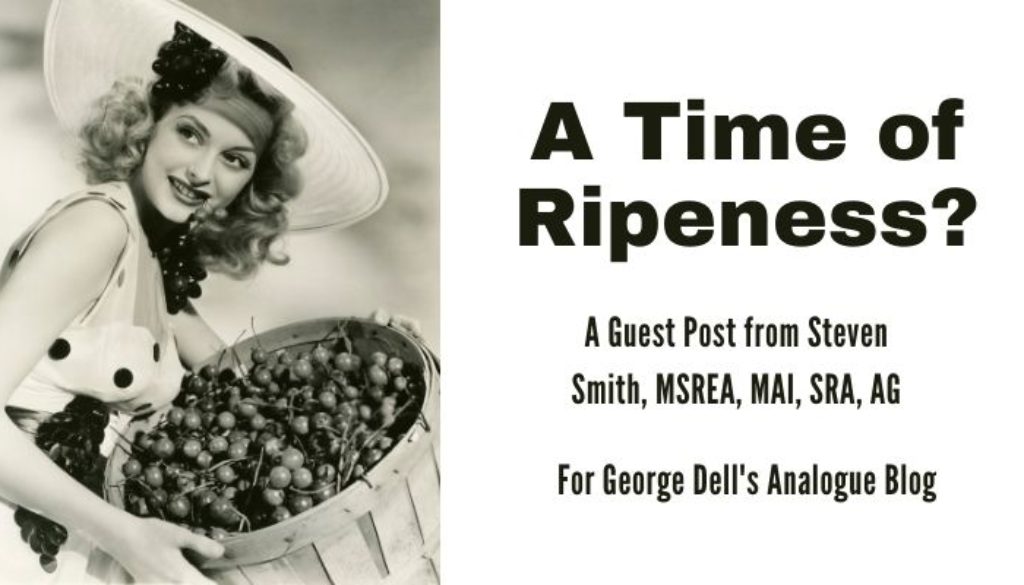This week’s blog, Is this a Time of Ripeness? is a guest post written by Steven Smith, MSREA, MAI, SRA, AG. See below for a more detailed bio.
Appraisal sins are forgiven when the markets are strong, and prices are increasing at double digit rates as they have been. Once prices stop going up, deficiencies often are given a harder look. I call this the Time of Ripeness, but what does that mean?
Ripeness is a legal term I learned from an Environmental Law course which means, a time to act after other remedies have been exhausted, although it is used in many different contexts. We are near the end of what had been a booming market, or, in some cases we are in markets that have turned. In that context, the Time is Ripe for appraisers to buckle down and deal with what is happening, as it is happening, or they will be over estimating values.
If, say, a particular market or market segment had increased by double digits in the last year at a rate of 2% per month, then it stopped going up 2-3 months ago and if appraisers are adjusting sales from months prior at the 2% rate, it will result in a higher indicator on each sale used.
 As markets slow down, marketing times become longer, then Listing prices start to be reduced and at some point, current Listing’s, and Pending’s are at price levels below the Closed Sales of the recent past.
As markets slow down, marketing times become longer, then Listing prices start to be reduced and at some point, current Listing’s, and Pending’s are at price levels below the Closed Sales of the recent past.
The hardest time to appraise is in a Changing Market. But how do we Know if or when a market changed? Having a Knowing is different than having a Belief. It is an active process that only individuals can achieve for themselves, not something we get the way we get Beliefs.
Having worked through several boom-and-bust markets, I came up with a way to actually measure what the Market was doing as it happens, a technique that gives me a Knowing. This first came to me in 1982 when we were three years into a declining market.
In my article entitled, Appraising in a Changing Market: The Multi-Tiered Market Data Approach, it includes 1} Closed sales less than 6-months, 2} Pending sales that competed under current market conditions, 3} Current offers. 4} Current listings, discounted, 5} Historic sales over 6-months. Once we have examined these Tiers, it becomes clear what the Market is doing.
If all we do is look at Closed sales and the Market is slowing, we will end up using older and older sales. Without Knowing what the Market is doing, we might continue making positive Time adjustments months after it stopped going up or even after the Market has been declining for months.
In 2005 I was predicting Market Declines in the range of 25%-50% and at a presentation I was giving, I was interrupted and told that the local market had never declined by an appraiser who had worked there 25-years. I too had worked there, so I Knew it had declined. At first, I was confounded by how an appraiser could not Know this. The answer came when I realized that if all you did was look for Closed Sales and went back further and further in time or farther away; one might truly never know what the Market was doing.
From my perspective the Time of Ripeness has arrived; what are you measuring in your Markets?
Our guest blogger this week is my long time friend and colleague, Steven R. Smith, MSREA, MAI, SRA. Steve has an MS in Real Estate Appraisal, BS in Real Estate Finance, MAI and SRA designations. Appraising since 1976, with prior experience in lending and sales. His Master’s thesis was on Real Estate Frauds, Mortgage Frauds and Appraisal Frauds. Steve works on civil and criminal cases as an expert witness and rebuttal witness. Cases range from casualty loss, eminent domain, partition, class action and professional liability. Steve is the founder and owner of the National Appraiser’s Forum, a free, moderated group for appraisers to bring their questions to consult with others to gain insight and information. To subscribe, go here: nationalappraisersforum-

June 1, 2022 @ 5:34 am
Excellent post! Knowing and believing are two separate concepts. When the appraiser and user of appraisal reports understand the difference, the value equation changes significantly.
June 6, 2022 @ 10:17 am
May want to ask a couple gals before you post another picture like that. Opps, older guy mistake.
June 6, 2022 @ 1:57 pm
Thank you, Jim, for the comment. You are the only person who mentioned it. We appreciate your insights. I create all the graphics, so don’t blame George. I am just a vintage woman using what speaks to me as a creator. And I’ve used this photo before on a blog post about (cherry) picking comps. Hope you are not offended by the picture or by my response. Cynthia Law, Executive Director of George Dell’s Valuemetrics.